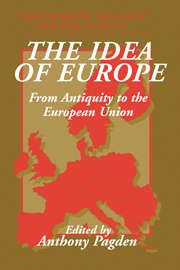Book contents
- Frontmatter
- Contents
- Acknowledgments
- Introduction
- 1 Europe: Conceptualizing a Continent
- 2 Some Europes in Their History
- 3 “Europe” in the Middle Ages
- 4 The Republican Mirror: The Dutch Idea of Europe
- 5 The Napoleonic Empire and the Europe of Nations
- 6 Homo Politicus and Homo Oeconomicus: The European Citizen According to Max Weber
- 7 The European Self: Rethinking an Attitude
- 8 European Nationalism and European Union
- 9 From the Ironies of Identity to the Identities of Irony
- 10 Muslims and European Identity: Can Europe Represent Islam?
- 11 The Long Road to Unity: The Contribution of Law to the Process of European Integration since 1945
- 12 The Euro, Economic Federalism, and the Question of National Sovereignty
- 13 Identity Politics and European Integration: The Case of Germany
- 14 Nationalisms in Spain: The Organization of Convivencia
- 15 The Kantian Idea of Europe: Critical and Cosmopolitan Perspectives
- Contributors
- Index
- Cambridge Cultural Social Studies
9 - From the Ironies of Identity to the Identities of Irony
Published online by Cambridge University Press: 14 July 2009
- Frontmatter
- Contents
- Acknowledgments
- Introduction
- 1 Europe: Conceptualizing a Continent
- 2 Some Europes in Their History
- 3 “Europe” in the Middle Ages
- 4 The Republican Mirror: The Dutch Idea of Europe
- 5 The Napoleonic Empire and the Europe of Nations
- 6 Homo Politicus and Homo Oeconomicus: The European Citizen According to Max Weber
- 7 The European Self: Rethinking an Attitude
- 8 European Nationalism and European Union
- 9 From the Ironies of Identity to the Identities of Irony
- 10 Muslims and European Identity: Can Europe Represent Islam?
- 11 The Long Road to Unity: The Contribution of Law to the Process of European Integration since 1945
- 12 The Euro, Economic Federalism, and the Question of National Sovereignty
- 13 Identity Politics and European Integration: The Case of Germany
- 14 Nationalisms in Spain: The Organization of Convivencia
- 15 The Kantian Idea of Europe: Critical and Cosmopolitan Perspectives
- Contributors
- Index
- Cambridge Cultural Social Studies
Summary
Europe, Europe as you watch me
descend helpless and lost into one of my
Frail myths among the hordes of beasts
I am a son of yours in flight who has no
Enemy other than his own sadness.
Vittorio Sereni, Diario d'Algeria August 1942When this poem was written, Europe was in the midst of a civil war between “hordes of beasts” (the Fascists) on one side and the anti-Fascists on the other, and its fate depended on the outcome of this conflict. The idea of a united Europe had been seized upon by both the Nazis and the Fascists in the period between the two wars, as well as during the war itself. Two examples of this are the Convegno Volta, a conference on Europe organized in 1932 under the auspices of the Fascist regime in Rome and the projects presented by Goebbels and Von Ribbentrop in 1942–3 for a “new Europe” to be united under Nazi dominion. Those who resisted the various types of Fascism and claimed to be “sons” of Europe could count on only a “frail myth”—if I may be allowed to extend Sereni's metaphor—and this myth projected a possible Europe and possible Europeanness into a completely uncertain future. At that time the sense of belonging to Europe was more of a wager than a reference to a given reality.
The tradition of a united Europe was centuries old, but the First World War had reduced it to ashes.
- Type
- Chapter
- Information
- The Idea of EuropeFrom Antiquity to the European Union, pp. 191 - 208Publisher: Cambridge University PressPrint publication year: 2002
- 8
- Cited by



